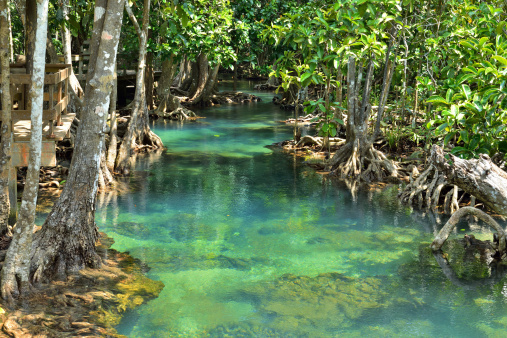
Water-related international agreements represent a key source of untapped regulatory potential.
Climate change presents the international community with a monumental regulatory problem that transcends generations, sectors, and political boundaries. Yet comprehensive climate change legislation on the international and national level seems a long way off, as countries appear unwilling to alter the course of their economic development without reciprocal commitments from the rest of the international community. In the absence of such comprehensive legislation, legal mechanisms that indirectly regulate climate change have emerged as viable, albeit interim, options. Among these mechanisms, international freshwater and ocean agreements are unappreciated sources of indirect climate change regulation.
The Ramsar Convention on Wetlands of International Importance Especially as Waterfowl Habitat, for example, aims to reverse the loss of wetlands through the adoption of “wise use” or sustainable use principles. The Ramsar Convention requires 168 contracting states to designate at least one area as a wetland of “international importance” in which the wise use of the wetland must be promoted in order to maintain its ecological character. With wetlands covering more than six percent of the Earth’s surface and playing a key role as sinks for carbon emissions, the convention’s ability to mobilize international support for wetlands conservation and wise utilization is a critical—and often neglected—component of the community’s mitigation and adaptation approach to climate change. To date 2,188 sites have been listed as internationally important wetlands, covering a total area of over 805,440 square miles.
Just as the Ramsar Convention represents an important international effort to protect wetlands, the 1994 United Nations Convention to Combat Desertification (UNCCD) aims to foster international cooperation to combat desertification and mitigate the effects of drought. The UNCCD explicitly recognizes the contribution “that combating desertification can make to achieving the objectives of the UN Framework Convention on Climate Change,” presumably because the challenges of combating desertification and mitigating the effects of drought are so intricately linked with climate change. Not only does climate change exacerbate desertification by making precipitation patterns more irregular, more direct forms of desertification—such as unsustainable agricultural practices and deforestation—eliminate another barrier ecosystem capable of absorbing atmospheric carbon dioxide. Thus, the UNCCD’s ability to mobilize support for combatting desertification has a significant impact on climate change mitigation and adaptation, while the treaty’s unique integration with the UNFCCC provides a model for future international environmental agreements to fit their objectives into a climate change framework.
Treaties regulating the world’s oceans have even greater potential to indirectly regulate climate change. The oceans are the Earth’s primary heat sink, and therefore its first line of defense against climate change. The Intergovernmental Panel on Climate Change reported in 2013 that ninety percent of the energy increase in the earth’s climate system from 1971-2010 was absorbed in the ocean, including sixty percent that was absorbed by the upper ocean (0-700 meters). Polar ice melts, rising sea levels, and ocean acidification are all a result of the climate change-induced alterations in oceanic processes.
Among the United Nations Convention on the Law of the Sea’s hundreds of provisions, two stand out for their potential to mitigate climate change or induce much-needed adaptation. First, the Convention reinforces the “common heritage of mankind” principle, which implicates collective action on matters or areas of collective concern. The principle promotes international stewardship of marine resources, while invoking notions of generational equity that pervade climate change regulation discourse.
Second, the Convention provides an incentive for states to prevent further increases in sea level rise. All states are entitled to certain privileges that extend outward from their nautical baseline. However, the baseline is defined as the low-water line along the coast, and sea level rise would obviously submerge lands that are unlikely to be productive underwater while diminishing the reach of each affected state’s various jurisdictional zones. Even a withdrawal of a few feet can have tremendous consequences for a state’s legal rights, especially in areas where jurisdictional zones are contiguous or overlapping.
The International Convention for the Prevention of Pollution from Ships (MARPOL) offers another, more direct, contribution to climate change regulation efforts. Annex VI of MARPOL establishes caps on the type and quantity of air pollutants contained in ships’ exhaust gasses, including nitrous oxides and sulfur oxides. Annex VI also prohibits the deliberate release of ozone depleting gases, and it establishes a mechanism for creating control areas in which emissions are further restricted. While regulations on pollution from ships may not seem terribly significant to global climate change processes, consider that in 2012 alone the world’s fleet included 80,000 ships that carried an overwhelming majority of global freight transport. In this context, regulating air pollutant emissions from merchant vessels has the potential to prompt significant reductions in global greenhouse gas emissions.
Further amendments to MARPOL’s Annex VI may yield even more promising climate change mitigation measures, as recently adopted energy efficiency standards for ships have been touted as the first legally binding international treaty since the Kyoto Protocol to directly address climate change. With international shipping estimated to have contributed 2.7% of global emissions in 2007, MARPOL’s emissions reduction schemes and widespread political support make the treaty a promising source of climate change mitigation.
Ultimately, because of the water cycle’s crucial role in climatic processes, international agreements regulating various aspects of the water cycle are uniquely positioned to indirectly contribute to climate change mitigation and adaptation. While they are not known as “climate” treaties, Ramsar, UNCCD, MARPOL, and the Law of the Sea Convention are making unique contributions to the climate change challenge. Given the political sensitivity of direct climate change regulation, international environmental agreements with climate linkages represent a significant source of untapped regulatory potential.



